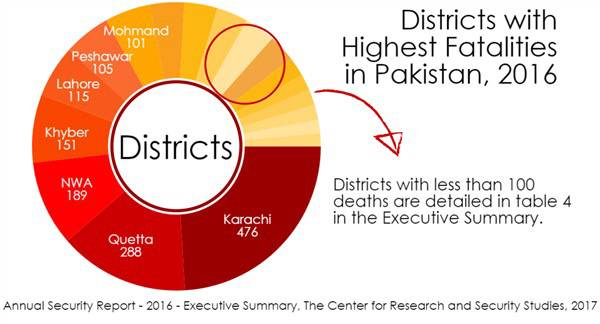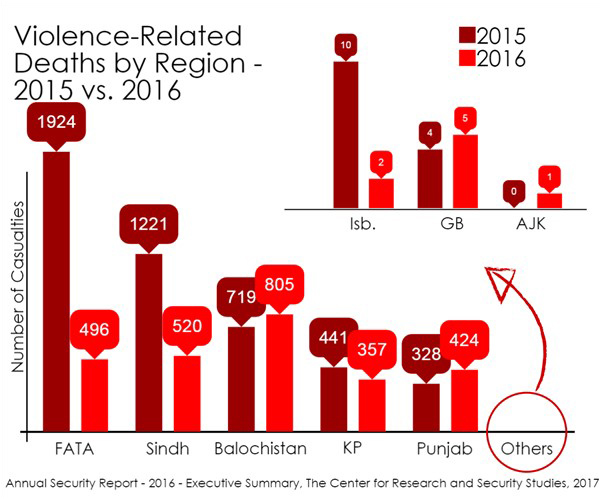
Data from the independent think tank, The Center for Research and Security Studies, shows there has been a significant and sharp decline in violence-related fatalities across Pakistan. Between 2015 and 2016, the figure dropped from 4,647 to 2,610, a 45% decline in overall casualties. Between 2014 and 2016, this decline is even more pronounced at over 66%. There is no doubt that the kinetic and combing operations in the country, including the non-international armed conflict in FATA, the urban pacification in Karachi, and the insurgent mollification in Balochistan have all contributed to an improving security situation.
Balochistan became the most violent region in the land with 805 violence-related deaths, followed by Sindh (520), the Federally Administered Tribal Areas (496), Punjab (424) and Khyber-Pukhtunkhwa (357).
Compared with 2015’s data, the reduction in violence-related fatalities is clear.
Aside from one spike in August, which witnessed the horrendous bombing targeting lawyers in Quetta, violence-related fatalities saw a consistent decline. December was the least violent month of the year with 93 fatalities. In March, Pakistan witnessed the Gulshan-e-Iqbal Park bombing that ostensibly targeted Christians, but ended up killing significantly more Muslims. This bombing was partly responsible for the most violent month of the year at 311 fatalities.

Despite Balochistan being the most violent province, Karachi district has the most fatalities at 476. This was followed by Quetta (288), North Waziristan Agency (189), Khyber Agency (151), Lahore (115), Peshawar (105), and Mohmand Agency (101). In 2014, there were 2,029 fatalities in Karachi alone, thus 2016’s figure represents a nearly 77% reduction in violence-related fatalities. Despite this massive reduction, Karachi District, owing primarily to the city of Karachi as its major population hub, continues to be the most violent district in the country.
Four districts of the country suffered the highest number of fatalities from sectarian violence during this year, with Lahore topping the list. This year, sectarian violence was reported from places that were hitherto unaffected such as Shah Noorani (Khuzdar), Mirpur Mathelo, Hyderabad, Chakwal, Buner, and Badin.
The success of the National Action Plan is rooted entirely in the efficiency of the kinetic operations being carried out in various parts of the country. However, work against the ideological foundations that result in extremism and militancy have seen limited to no action, and seem hampered by a distinct lack of political will. It is hoped that with the newly appointed NSA General Janjua, there will be greater impetus to target the long-term root causes of radicalization in the country. All things considered, a 66% reduction in violence-related fatalities in Pakistan over the last two years is a welcome development, albeit a potentially unsustainable and artificial one.
The writer is a senior research fellow at the Center for Research and Security Studies, Islamabad. He can be reached at zeeshan.salahuddin@gmail.com and @zeesalahuddin
Balochistan became the most violent region in the land with 805 violence-related deaths, followed by Sindh (520), the Federally Administered Tribal Areas (496), Punjab (424) and Khyber-Pukhtunkhwa (357).
Compared with 2015’s data, the reduction in violence-related fatalities is clear.
Aside from one spike in August, which witnessed the horrendous bombing targeting lawyers in Quetta, violence-related fatalities saw a consistent decline. December was the least violent month of the year with 93 fatalities. In March, Pakistan witnessed the Gulshan-e-Iqbal Park bombing that ostensibly targeted Christians, but ended up killing significantly more Muslims. This bombing was partly responsible for the most violent month of the year at 311 fatalities.

Despite Balochistan being the most violent province, Karachi district has the most fatalities at 476. This was followed by Quetta (288), North Waziristan Agency (189), Khyber Agency (151), Lahore (115), Peshawar (105), and Mohmand Agency (101). In 2014, there were 2,029 fatalities in Karachi alone, thus 2016’s figure represents a nearly 77% reduction in violence-related fatalities. Despite this massive reduction, Karachi District, owing primarily to the city of Karachi as its major population hub, continues to be the most violent district in the country.
Four districts of the country suffered the highest number of fatalities from sectarian violence during this year, with Lahore topping the list. This year, sectarian violence was reported from places that were hitherto unaffected such as Shah Noorani (Khuzdar), Mirpur Mathelo, Hyderabad, Chakwal, Buner, and Badin.
The success of the National Action Plan is rooted entirely in the efficiency of the kinetic operations being carried out in various parts of the country. However, work against the ideological foundations that result in extremism and militancy have seen limited to no action, and seem hampered by a distinct lack of political will. It is hoped that with the newly appointed NSA General Janjua, there will be greater impetus to target the long-term root causes of radicalization in the country. All things considered, a 66% reduction in violence-related fatalities in Pakistan over the last two years is a welcome development, albeit a potentially unsustainable and artificial one.
The writer is a senior research fellow at the Center for Research and Security Studies, Islamabad. He can be reached at zeeshan.salahuddin@gmail.com and @zeesalahuddin

